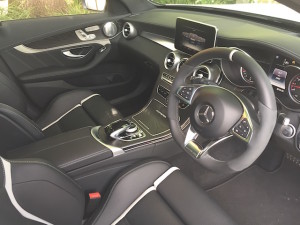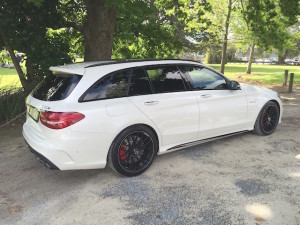
I was having a beer with a couple of Mercedes-Benz engineers in Berlin in the early 1990s. The digital revolution was gaining momentum and talk turned to safety advances. Benz had not long equipped its premium S-Class with anti-lock braking and, like its competitors, was working on further safety devices. One of the engineers painted a light-hearted picture of ‘his’ safest car: it would be six metres long, three metres wide, with room for one occupant only – the driver. The driver would sit on a centre line towards the rear and encased in a protective cage that would itself be surrounded by crash crumple zones. He said the car would cost around a million dollars – but be totally impractical. He can be forgiven for perhaps not realising 20-odd years ago that the digital age would reinvent pretty much everything, including much of the wheel.  Take the blend of mechanical and digital components in the Mercedes-AMG C63 S sedan or station wagon. The ‘S’ badge denotes a bunch of things, notably that its high-tech 4.0-litre V8 engine has twin turbos that spin at 186,000rpm to help deliver a lag-less 375kW of power and 700Nm of torque, and it uses an electronically controlled differential to distribute all that oomph between the rear wheels. Other digital gizmos control the way the car’s seven-speed gearbox channels it. Mixing mechanical, digital and gearboxes can be messy. The digital message gets to the mechanical system quickly enough, but the mechanicals can take some time to interpret it. Not in the C63 S. The AMG Speedshift MCT (multi-clutch transmission) does the business without a torque converter and instead uses clutches and bands for each gear to provide millisecond changes. Therein lies the key to what the drivetrain in the C63 S is all about, that and selectable drive functions. There are five settings: Individual, Comfort, Sport, Sport Plus, Race. Individual allows the driver to tune the engine, transmission, steering, and suspension and stability systems to suit. A couple of other buttons help here. Want a lazy day at the wheel but with underlying menace? Go Comfort. Want urgent everything and a 0-100km/h time of 4.1 seconds? Go Race mode. Want optimum performance? Set the engine and transmission to Race, the
Take the blend of mechanical and digital components in the Mercedes-AMG C63 S sedan or station wagon. The ‘S’ badge denotes a bunch of things, notably that its high-tech 4.0-litre V8 engine has twin turbos that spin at 186,000rpm to help deliver a lag-less 375kW of power and 700Nm of torque, and it uses an electronically controlled differential to distribute all that oomph between the rear wheels. Other digital gizmos control the way the car’s seven-speed gearbox channels it. Mixing mechanical, digital and gearboxes can be messy. The digital message gets to the mechanical system quickly enough, but the mechanicals can take some time to interpret it. Not in the C63 S. The AMG Speedshift MCT (multi-clutch transmission) does the business without a torque converter and instead uses clutches and bands for each gear to provide millisecond changes. Therein lies the key to what the drivetrain in the C63 S is all about, that and selectable drive functions. There are five settings: Individual, Comfort, Sport, Sport Plus, Race. Individual allows the driver to tune the engine, transmission, steering, and suspension and stability systems to suit. A couple of other buttons help here. Want a lazy day at the wheel but with underlying menace? Go Comfort. Want urgent everything and a 0-100km/h time of 4.1 seconds? Go Race mode. Want optimum performance? Set the engine and transmission to Race, the
stability system to Sport or Sport Plus, and the suspension to Comfort. That way you get a lickety-split throttle, millisecond gear changes, and a barking exhaust; stability and traction that allows you to play with the rear end while knowing there’s a safety net of sorts; and a suspension set-up that remains firm but is AMG’s interpretation of compliant.  The C63 S sits 25mm lower and its front track is 31mm wider than the standard C-Class. It rides on 19-inch alloys, gets firmer springs all round and larger-diameter anti-roll bars. Take it as read that the brakes are as good as it gets. Inside, there’s a mix of conventional analogue dials with a central computer screen that shows up oil temperature readouts, turbo boost gauge and lap timer. View from the driver’s seat is excellent and overall cabin space is good. The boot is shallow but more than adequate. It’s a Walter Mitty-type character, the C63 S: there’s always another side to its personality. It can be a race car or a sneaky sleeper. Its V8 engine has another side too. It was born of two 1991cc four-cylinder banks from the Mercedes-AMG A45 hatchback, hence its capacity of 3982cc, or two times 1991cc. In a nutshell, the C63 S wagon is hugely flexible, poised, has great grip, great presence, and a traction/stability system so finely tuned that it can loosen the shackles when you want to play. The front axle always knows what the rear axle is doing. All that adds to up to an exciting carry-all, refined in so many ways but as loud as a heavy metal band. There’s plenty of road noise as the wide rubber slaps against the road, the tied-down suspension components bump and grind over all but the smoothest surfaces, and the exhaust barks and growls. Still, it’s got a lot to shout about, starting with the base price of $167,900.
The C63 S sits 25mm lower and its front track is 31mm wider than the standard C-Class. It rides on 19-inch alloys, gets firmer springs all round and larger-diameter anti-roll bars. Take it as read that the brakes are as good as it gets. Inside, there’s a mix of conventional analogue dials with a central computer screen that shows up oil temperature readouts, turbo boost gauge and lap timer. View from the driver’s seat is excellent and overall cabin space is good. The boot is shallow but more than adequate. It’s a Walter Mitty-type character, the C63 S: there’s always another side to its personality. It can be a race car or a sneaky sleeper. Its V8 engine has another side too. It was born of two 1991cc four-cylinder banks from the Mercedes-AMG A45 hatchback, hence its capacity of 3982cc, or two times 1991cc. In a nutshell, the C63 S wagon is hugely flexible, poised, has great grip, great presence, and a traction/stability system so finely tuned that it can loosen the shackles when you want to play. The front axle always knows what the rear axle is doing. All that adds to up to an exciting carry-all, refined in so many ways but as loud as a heavy metal band. There’s plenty of road noise as the wide rubber slaps against the road, the tied-down suspension components bump and grind over all but the smoothest surfaces, and the exhaust barks and growls. Still, it’s got a lot to shout about, starting with the base price of $167,900.
